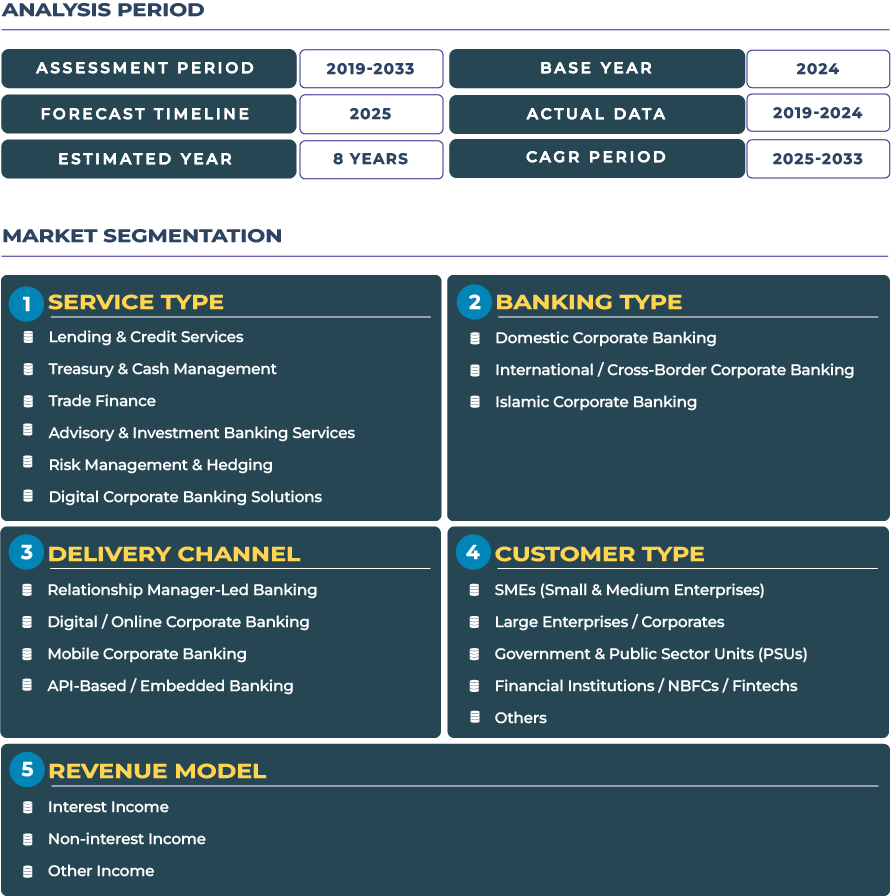SME and Mid-Market Corporate Banking Solutions in Colombia: Driving Growth and Digital Adoption
The Colombia Corporate Banking Market is undergoing a strategic transformation, led by a growing focus on SME and mid-market corporate clients. Colombian banks are investing in advanced digital solutions, diversified lending models, and fintech collaborations to expand credit access for mid-sized enterprises and strengthen liquidity management across industries. As Colombia’s economy stabilizes post-pandemic and inflation moderates, corporate banks are emphasizing digital treasury, trade finance, and lending platforms tailored to the needs of expanding businesses.
Note:* The market size refers to the total revenue generated by banks through interest income, non-interest income, and other ancillary sources.
According to DataCube Research, the Colombia Corporate Banking Market is estimated at USD 15.0 billion in 2025 and projected to reach USD 19.6 billion by 2033, growing at a CAGR of 3.4% from 2025 to 2033. This growth is supported by increasing digital adoption among SMEs, the rapid expansion of fintech partnerships, and rising demand for corporate advisory and liquidity services. The Superintendencia Financiera de Colombia continues to support modernization of digital corporate banking systems to strengthen regulatory transparency and risk management frameworks.
Market Outlook: Expanding SME and Mid-Market Financing Fuels Banking Innovation
Colombia corporate banking sector is entering a new growth phase powered by the digital transformation of SME and mid-market financing. The shift towards cashless payments, virtual account management, and credit automation has created opportunities for banks to serve previously underserved business segments. Banks such as Banco de Bogotá are leveraging digital ecosystems to deliver real-time treasury management and advisory solutions for clients in logistics, agriculture, and services.
Government initiatives promoting credit inclusion through digital channels have further accelerated adoption. As Colombia deepens its trade partnerships and infrastructure investments, mid-market firms are increasingly turning to banks for structured trade finance, FX hedging, and risk management. These changes are positioning the corporate banking ecosystem as a key enabler of enterprise growth, export expansion, and domestic investment diversification across the nation’s industrial regions.
Drivers and Restraints: Balancing Growth Opportunities and Economic Challenges
Rising Export and Energy Sector Demand Boosting Corporate Lending
The growth of Colombia corporate banking industry is largely influenced by the energy, oil, and mining sectors’ demand for structured trade and export financing. Multinationals and large Colombian corporates are increasingly requiring complex treasury and project finance solutions to manage supply chain liquidity and foreign exchange exposures. Growing export hubs such as Cartagena and Barranquilla are driving up the need for banking partnerships supporting logistics financing and cross-border settlements.
Digital Partnerships and Fintech Collaborations Enhancing Service Delivery
Colombia’s fintech partnerships are redefining how corporate clients access financial products. From digital payment platforms to cloud-based treasury solutions, collaboration between banks and fintech firms is expanding. The Banco de la República’s initiatives to foster financial digitalization have led to the growth of secure and interoperable payment systems for SMEs and mid-market corporates. This is enabling corporate banks to enhance transaction transparency and streamline liquidity management.
Political Volatility and Rural Financial Gaps Restricting Corporate Access
Despite progress, the Colombia corporate banking sector continues to face challenges from regional political instability and uneven access to banking in rural areas. Limited connectivity and persistent security concerns in certain provinces hinder the extension of branchless banking and supply chain finance services. Furthermore, fluctuations in oil and commodity prices create volatility in corporate cash flows, often affecting lending and risk appetite within the financial ecosystem.
Trends and Opportunities: Advancing Export Finance, Digital Supply Chains, and Liquidity Management
Export Finance and Supplier Credit Solutions Expanding Corporate Ecosystem
A key trend in the Colombia corporate banking landscape is the expansion of export finance and supplier credit solutions. Banks are increasingly offering pre- and post-shipment financing to firms involved in oil, coffee, and agricultural exports. Regional banks are also exploring receivables financing structures that improve working capital cycles for exporters and service providers. This is especially relevant for mid-sized firms seeking liquidity stability amid currency fluctuations.
Digital Cash Management Transforming Mid-Market Corporate Services
Corporate banks in Colombia are adopting cloud-based treasury management tools that allow businesses to monitor and optimize cash positions in real time. These platforms enable enterprises to reduce dependency on manual cash forecasting and to integrate payments with enterprise resource planning (ERP) systems. The rise of corporate pooling and digital FX hedging is further reinforcing corporate agility in volatile market conditions.
Opportunity in SME Advisory and Digital Transformation Finance
There is a growing opportunity for banks to provide advisory and financing for SMEs undergoing digital transformation. As e-commerce and logistics sectors expand, the demand for asset-backed loans and digital trade solutions is increasing. Banks are aligning financing models with ESG priorities, supporting sustainable projects, and encouraging responsible lending practices that align with Colombia’s green finance objectives.
Competitive Landscape: Corporate Banks Deepening Digital and Sectoral Focus
The Colombia corporate banking ecosystem is dominated by major institutions such as Bancolombia, Banco de Bogotá, and Banco Davivienda, alongside international banks expanding local trade and treasury operations. These banks are strengthening sectoral finance for mining, agriculture, and logistics clients while implementing digital platforms that integrate receivables management and liquidity forecasting. In 2024, Bancolombia launched a new API-based platform aimed at corporate clients for seamless treasury integration and data-driven advisory services. Similarly, Banco Davivienda expanded its digital trade finance suite to facilitate faster FX settlements for exporters.
As corporate clients demand more specialized financing, leading banks are introducing product bundles combining risk management, investment advisory, and multi-currency accounts. The focus on customer-centric innovation is enabling Colombian banks to enhance service efficiency and maintain competitiveness in an evolving financial environment.







